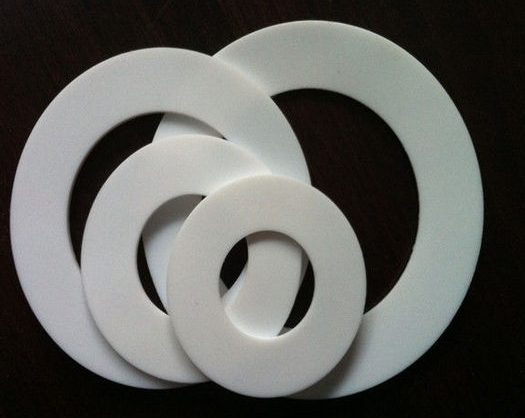- 13
- Nov
PTFE-Dichtung
PTFE-Dichtung
PTFE gaskets have excellent properties of creep resistance, cold flow resistance, ultra-low temperature resistance, no pollution, and easy installation and disassembly. Under a small pre-tightening force, it can withstand considerable internal pressure even in a pressure fluctuation environment. It is very suitable for rough or unevenly worn and fragile glass-faced flanges and temperature-changing sealing occasions. We can choose Gore, Klinger, Garlock, Sealon and other expanded PTFE sheets for customers to produce the required gaskets for customers.
Vorteil
Hohe Temperaturbeständigkeit – die Arbeitstemperatur kann 250 erreichen.
Niedertemperaturbeständigkeit-hat eine gute mechanische Zähigkeit; selbst wenn die Temperatur auf -196 ℃ sinkt, kann es eine Dehnung von 5% aufrechterhalten.
Korrosionsbeständigkeit – Es ist inert gegenüber den meisten Chemikalien und Lösungsmitteln und kann starken Säuren und Laugen, Wasser und verschiedenen organischen Lösungsmitteln standhalten.
Weather resistance-has excellent aging life in plastics.
High lubrication-is the low coefficient of friction in solid materials.
Non-adhesion-it means that the surface tension in the solid material is small and does not adhere to any substance. Its mechanical properties have a very small friction coefficient, which is only 1/5 of that of polyethylene. This is an important feature of the perfluorocarbon surface. In addition, because the fluorine-carbon chain intermolecular forces are extremely low, PTFE is non-sticky.
Non-toxic and harmful-with physiological inertia, as an artificial blood vessel and organ implanted in the body for a long time without adverse reactions.
Elektrische Eigenschaften Polytetrafluorethylen hat eine niedrige Dielektrizitätskonstante und einen Dielektrizitätsverlust in einem breiten Frequenzbereich sowie eine hohe Durchbruchspannung, Durchgangswiderstand und Lichtbogenbeständigkeit.
Radiation resistance Polytetrafluoroethylene has poor radiation resistance (104 rad), and it degrades after being exposed to high-energy radiation, and the electrical and mechanical properties of the polymer are significantly reduced. Application Polytetrafluoroethylene can be formed by compression or extrusion processing; it can also be made into water dispersion for coating, dipping or making fibers. PTFE is widely used as high and low temperature resistant, corrosion resistant materials, insulating materials, anti-stick coatings, etc. in nuclear energy, aerospace, electronics, electrical, chemical, machinery, instruments, meters, construction, textiles, food and other industries.
Atmosphärische Alterungsbeständigkeit: Strahlungsbeständigkeit und geringe Durchlässigkeit: Bei längerer Exposition gegenüber der Atmosphäre bleiben Oberfläche und Leistung unverändert.
Nichtbrennbarkeit: Der Sauerstoffgrenzindex liegt unter 90.
Säure- und Laugenbeständigkeit: unlöslich in starken Säuren, starken Laugen und organischen Lösungsmitteln.
Oxidationsbeständigkeit: beständig gegen Korrosion durch starke Oxidationsmittel.
Säure: Neutral.
Die mechanischen Eigenschaften von PTFE sind relativ weich. Hat eine sehr niedrige Oberflächenenergie.
Polytetrafluoroethylene (F4, PTFE) has a series of excellent performance: high temperature resistance-long-term use temperature of 200~260 degrees, low temperature resistance-still soft at -100 degrees; corrosion resistance-resistance to aqua regia and all organic solvents; Weather resistance-aging life in plastics; high lubrication-with a small coefficient of friction (0.04) in plastics; non-stickiness-with low surface tension in solid materials without adhesion of any substances; non-toxic-with physiological inertness; excellent electrical properties , Is an ideal C-level insulating material.

